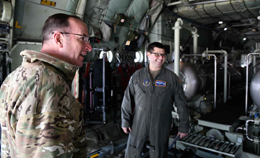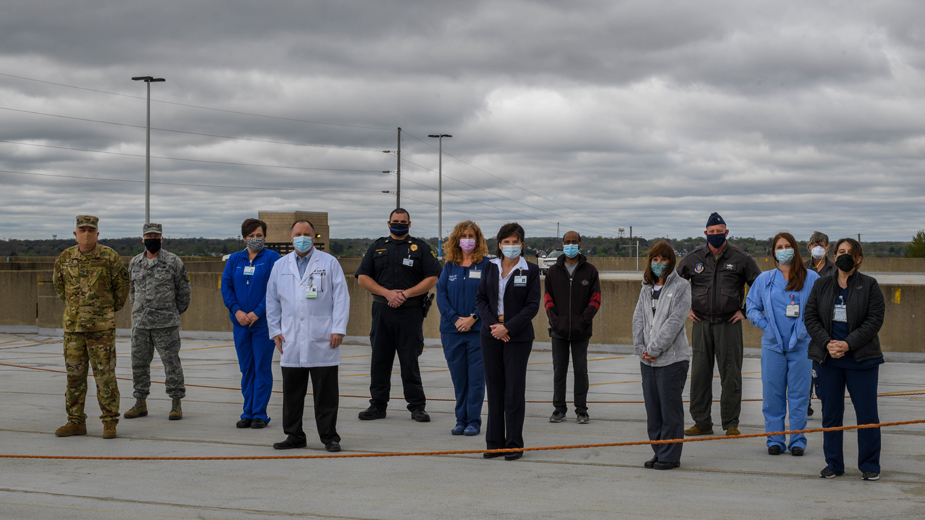It wasn’t long ago that the future of Youngstown Air Reserve Station was, at best, gloomy. Seven years ago, the Air Force relocated four of the 910th Airlift Wing’s C-130 planes and 200 jobs.
But in the time since, advocacy efforts have shored up those doubts and new links have been forged between the installation and the communities that surround the base. The latest of those projects is the YARS Joint Land Use Study, completed last fall and set for the first phase of implementation.
Consulting firm Matrix Design Group in conjunction with leaders from YARS, the Youngstown/Warren Regional Chamber’s Eastern Ohio Military Affairs Commission and Trumbull County, as well as area stakeholders created the study, more than 200 pages long. It was funded in part by the Department of Defense Office of Economic Adjustment.
With information such as recommended land uses near the air station, legislative initiatives and land/air space competition, the study serves as a playbook for development around YARS.
“This shows you what symbiotic and complementary growth looks like. You have this asset in your community and here are the recommendations and studies you can use to develop well into the future without interfering with each other,” says Vito Abruzzino, director of the Eastern Ohio Military Affairs Commission. “Nothing is forcing the base to do anything, but it gives guidelines. This is the Department of Defense saying, ‘This is what we’d like to see. Here’s what you can do as a community to make sure your base stays strong.’ ”
The full report and executive summary can be read at YARSJLUS.com.
In mid-June, Trumbull County posted a request for proposals to address the first group of recommendations, Abruzzino says, items that are “most ripe to pursue.” On that list are antiterrorism and force protection, light and glare, energy development, land use, communication and coordination, legislation and water quality.
To implement the first stages of development, Trumbull County was awarded a $399,725 grant – plus a 10% match from the county, bringing the total to $444,150 – for deliverables from the recommendations. Those efforts could take many forms, Abruzzino says, but points to mailers to nearby residents, state legislation to create “clear zones” for drones near Department of Defense sites and a 3D surfaces model as examples of how the funds could be used.
“You’ll be able to point to a location on a digital map and see things like the FAA restrictions on how high a building can be or the population density that can be there,” he says of the 3D model. “It’s not that you can’t have a higher density, but it can be a mark in the negative column.”
The land use study is just the second completed for a military installation in Ohio – Wright-Patterson Air Force Base had one done in 1997 and is in the process of updating it – and one of “the low hundreds” performed nationwide, the military affairs commission director says.
“To get one here for our installation is impressive,” Abruzzino says. “It tells you in plain language, ‘You should do these things if you want this to be here in the future.’ It made the playbook. Now, our job is to – say we don’t get grant funding from the OEA next time – come together as a community and decide how we can fund X, Y and Z.”
Already, one recommendation – force protection – is underway.
Two years ago, Youngstown Air Reserve Station was awarded $8.8 million through the National Defense Authorization Act to build a new front gate. The new entrance is entirely designed, says Master Sgt. Bob Barko, superintendent of public affairs at YARS, and awaits Gov. Mike DeWine’s signature on a funding bill to free up the last dollars needed to purchase the property.
“It’s something that, when it comes to force protection and antiterrorism, puts us in the position of being on the cutting edge of technology,” Barko says. “If you’ve been to the base, you realize how close it is to the road. At other active-duty installations, that’s not the case. When YARS was built in 1951, it wasn’t an issue to be six car lengths from the road. But 70 years later, the world has changed and they want as much offput as possible.”
The air station is also waiting to hear about the four C-130J Hercules planes allocated to it in the last National Defense Authorization Act. The holdup, Barko says, is Air Force Reserve Command studying where to put the planes in its forces and the Trump Administration moving military funds to pay for a wall along the United States-Mexico border.

“We did get word down that the study was put on hold because the Air Force’s position is they want to wait until there are eight aircraft, a full squadron, before they make their decision as to where to base those planes,” Barko says.
For the eight C-130s already housed at YARS, new aerial spray systems are in the pipeline. The 910th Airlift Wing is the Department of Defense’s only aerial spray mission, used to spray pesticides after natural disasters, or herbicide to keep large areas on military installations clear.
Battelle Memorial Institute, based in Columbus, is “working on the last few tweaks” to the newest modular aerial spray system, Barko says.
Funding for the project was awarded to Battelle in 2007 and the first test system is set to be installed later this year. After that, Barko says, final adjustments will be made and Battelle will build five more.
YARS leadership will serve as part of the committee to execute the recommendations from the joint land use study, Barko says, although he notes that most of the work to be performed falls outside the station’s borders. Still, the projects will strengthen YARS’ position.
“The majority of this, if not all of it, happens outside the gates. There are some things out on the runways, with us being an air station, but we don’t own those. That belongs to the port authority,” he says. “Ultimately, all of these projects are win-wins for us and the community as we figure out ways to strengthen the military value of the air station and continue to be good neighbors to our communities.”
Although nothing is carved in stone, the Eastern Ohio Military Affairs Commission’s Abruzzino has a short wish list for more developments at Youngstown Air Reserve Station. Among them is lengthening the runway 1,000 feet, to take it to 10,000 feet. That would make YARS eligible for more projects from the Department of Defense.
“Any Air Force aircraft can use our landing strip as it is currently at 9,000 feet. But if you want to base them there, it’s almost like an Airbnb. If you’re looking for something dog-friendly, you check that box. If the Air Force wants a 10,000-foot runway, they check off that option,” he says. “Once you make the shortlist, that’s when you can really advocate and lobby to try to land those missions.”
And with the recent “Voltage Valley” effort, Abruzzino envisions a future where Lordstown Motors Corp. and the GM-LG Chem battery plant work with the defense department to develop new technologies and vehicles.
“The armed forces community is always looking for next-gen ideas for ground transportation,” he says. “If you have a training center in Camp Garfield, the mobility piece with YARS and Lordstown Motors and the battery plant, we should absolutely be working on something that can be demonstrated for special forces command to try to get some research dollars. We could do everything right here.”
Pictured: 910th Airlift Wing leadership and employees from St. Elizabeth Youngstown Hospital pose for a photo on top of the hospital parking deck. Aircrew members assigned to the 757th Airlift Squadron flew two C-130H Hercules aircraft over hospitals in the region as part of the “America Strong” movement started by the U.S. Air Force Thunderbirds to salute first responders and medical workers during the pandemic. U.S. Air Force photo by Senior Airman Christina Russo.
